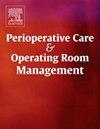PID air pressure controller in a positive pressure screening cabinet (PPS-Cabinet) for healthcare operator screening of SARS-CoV-2 infection
IF 1
Q2 Nursing
Perioperative Care and Operating Room Management
Pub Date : 2025-05-08
DOI:10.1016/j.pcorm.2025.100497
引用次数: 0
Abstract
This paper presents the implementation of a PID pressure controller for a Positive Pressure Screening Cabinet (PPS Cabinet), designed to reduce the risk of COVID-19 transmission to healthcare personnel. The PPS Cabinet was designed, constructed, and tested to optimize internal pressure by adjusting the proportional (Kp), integral (Ki), and derivative (Kd) gains of the PID controller. In the experimental setup, the cabinet has a total volume of 2.88 m³. A PID controller integrated with a Programmable Logic Controller (PLC) receives a 0–10 V analog signal from a pressure transducer and is programmed using a standard PID algorithm. The Kp, Ki, and Kd values were determined using the Ziegler-Nichols tuning method. Testing scenarios included opening and closing the cabinet door, both with and without an airlock chamber. Results indicate that the PID controller effectively regulates cabinet pressure, with optimal tuning values identified as Kp = 0.6, Ki = 0.4, and Kd = 0.4. While the PPS Cabinet without an airlock is deemed suitable for practical use, door opening causes a pressure drop below 0 Pa, posing a significant risk to healthcare workers. However, incorporating an airlock chamber maintains pressure above 0 Pa, thereby enhancing safety and reducing the likelihood of COVID-19 transmission to operators.
用于医护人员SARS-CoV-2感染筛查的正压筛查柜(PPS-Cabinet)中的PID气压控制器
本文介绍了一种用于正压筛选柜(PPS柜)的PID压力控制器的实现,旨在降低COVID-19对医护人员的传播风险。PPS柜的设计、构造和测试通过调整PID控制器的比例(Kp)、积分(Ki)和导数(Kd)增益来优化内部压力。在实验装置中,箱体的总容积为2.88 m³。与可编程逻辑控制器(PLC)集成的PID控制器接收来自压力传感器的0-10 V模拟信号,并使用标准PID算法进行编程。Kp、Ki和Kd值采用齐格勒-尼科尔斯调谐法测定。测试场景包括打开和关闭有和没有气闸室的柜门。结果表明,PID控制器能有效调节机柜压力,最优整定值分别为Kp = 0.6、Ki = 0.4、Kd = 0.4。虽然没有气闸的PPS柜被认为适合实际使用,但打开门会导致压力降至0 Pa以下,对医护人员构成重大风险。然而,安装气闸室将压力保持在0 Pa以上,从而提高了安全性并降低了将COVID-19传播给操作人员的可能性。
本文章由计算机程序翻译,如有差异,请以英文原文为准。
求助全文
约1分钟内获得全文
求助全文
来源期刊

Perioperative Care and Operating Room Management
Nursing-Medical and Surgical Nursing
CiteScore
1.30
自引率
0.00%
发文量
52
审稿时长
56 days
期刊介绍:
The objective of this new online journal is to serve as a multidisciplinary, peer-reviewed source of information related to the administrative, economic, operational, safety, and quality aspects of the ambulatory and in-patient operating room and interventional procedural processes. The journal will provide high-quality information and research findings on operational and system-based approaches to ensure safe, coordinated, and high-value periprocedural care. With the current focus on value in health care it is essential that there is a venue for researchers to publish articles on quality improvement process initiatives, process flow modeling, information management, efficient design, cost improvement, use of novel technologies, and management.
 求助内容:
求助内容: 应助结果提醒方式:
应助结果提醒方式:


